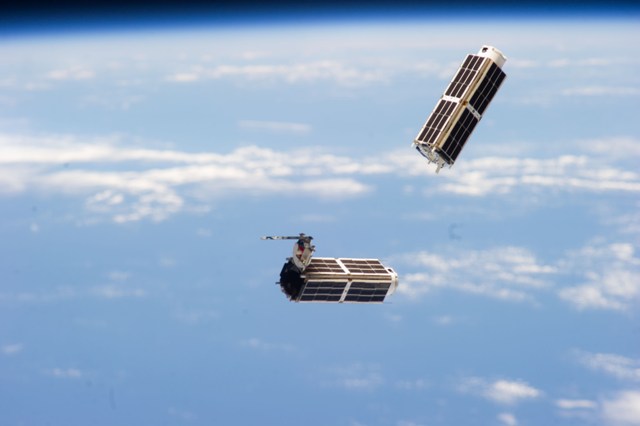Feb 3 2016
Just a bit bigger than a box of cereal, one of the first CubeSats to travel in interplanetary space will be NASA’s miniature space science station, dedicated to studying the dynamic particles and magnetic fields that stream from the sun.
 On Feb. 2, 2016, NASA announced which CubeSats will fly on the inaugural flight of the agency's Space Launch System in late 2018. CubeSats are small satellites, about the size of a cereal box, which provide an inexpensive way to access space. This file photo shows a set of NanoRacks CubeSats in space after their deployment in 2014. Credits: NASA
On Feb. 2, 2016, NASA announced which CubeSats will fly on the inaugural flight of the agency's Space Launch System in late 2018. CubeSats are small satellites, about the size of a cereal box, which provide an inexpensive way to access space. This file photo shows a set of NanoRacks CubeSats in space after their deployment in 2014. Credits: NASA
The CubeSat to study Solar Particles, or CuSP, will hitch a ride out of Earth orbit aboard NASA’s Space Launch System, or SLS, which is scheduled for an uncrewed test launch in late 2018. Once the CubeSat is ejected, it will orbit around the sun in interplanetary space, measuring incoming radiation that can create a wide variety of effects at Earth, from interfering with radio communications to tripping up satellite electronics to creating electric currents in power grids.
"CuSP will be able to observe events in space hours before they reach Earth," said Mihir Desai,
the principal investigator for CuSP at the Southwest Research Institute in San Antonio, Texas. "Such interplanetary observations would give us significant insight into what drives space weather, helping scientists to improve their simulations."
CuSP is a six-unit CubeSat, meaning it has a total volume of about six liters. This micro-satellite will carry three instruments, and the observations from those instruments will give us an unprecedented look at our interplanetary space environment, which is driven by the sun. The sun releases a constantly-flowing stream of particles and magnetic fields, known as the solar wind. Interspersed are faster, denser clouds of solar wind material, known as coronal mass ejections, or CMEs. When these CMEs – or even a particularly fast stream of solar wind – reach Earth, they can interact with Earth’s magnetic field, creating what's called a geomagnetic storm. It is the buffeting of the magnetic fields and the release of energy that can stress power grids and impact space technology. To understand these effects on Earth, scientists want to track how the space environment changes and develops between the sun and Earth.
Currently, measurements of the space environment come from a dozen or so satellites, all carrying different sets of instruments. Most of these satellites are in one of two basic orbits – circling either Earth or the L1 Lagrange point, a point between Earth and the sun about a million miles from us.
“Right now, it’s like we’re trying to understand weather for the entire Pacific Ocean with just a handful of weather stations,” said Eric Christian, lead Goddard scientist for CuSP. “We need to collect data from more locations.”
To create a network of space weather stations would require many instruments scattered throughout space millions of miles apart. But the cost of putting together such a system built out of full-fledged satellite missions is prohibitive. CubeSats like CuSP might be able to help solve the problem. Though the satellites can only carry a few instruments apiece, they’re relatively inexpensive to launch because of their small mass and standardized design. So, CuSP also serves as a test for creating a network of space science stations.
“If you had, say, 20 CubeSats in different orbits, you could really start to understand the space environment in three dimensions,” said Christian.
The three instruments that CuSP carries will each provide a different contribution. The Suprathermal Ion Spectrograph, or SIS, is built by the Southwest Research Institute to detect and characterize low-energy solar energetic particles. NASA Goddard’s Miniaturized Electron and Proton Telescope, or MERiT, will return counts of high-energy solar energetic particles. Finally, the Vector Helium Magnetometer, or VHM, being built by NASA’s Jet Propulsion Laboratory, will measure the strength and direction of magnetic fields.
CuSP was born of opportunity. Originally CuSPP, for CubeSat to study Solar Particles over the Poles, it was slated to fly in low-Earth orbit, studying solar particles near Earth’s poles. But when the call went out for CubeSats to fly on SLS, the team realized they had an opportunity to do some serious interplanetary space weather research for a fraction of the usual cost.
With only a relatively small amount of additional funding to reconfigure the satellite and instruments, the team won a spot on SLS for a ride to interplanetary space.